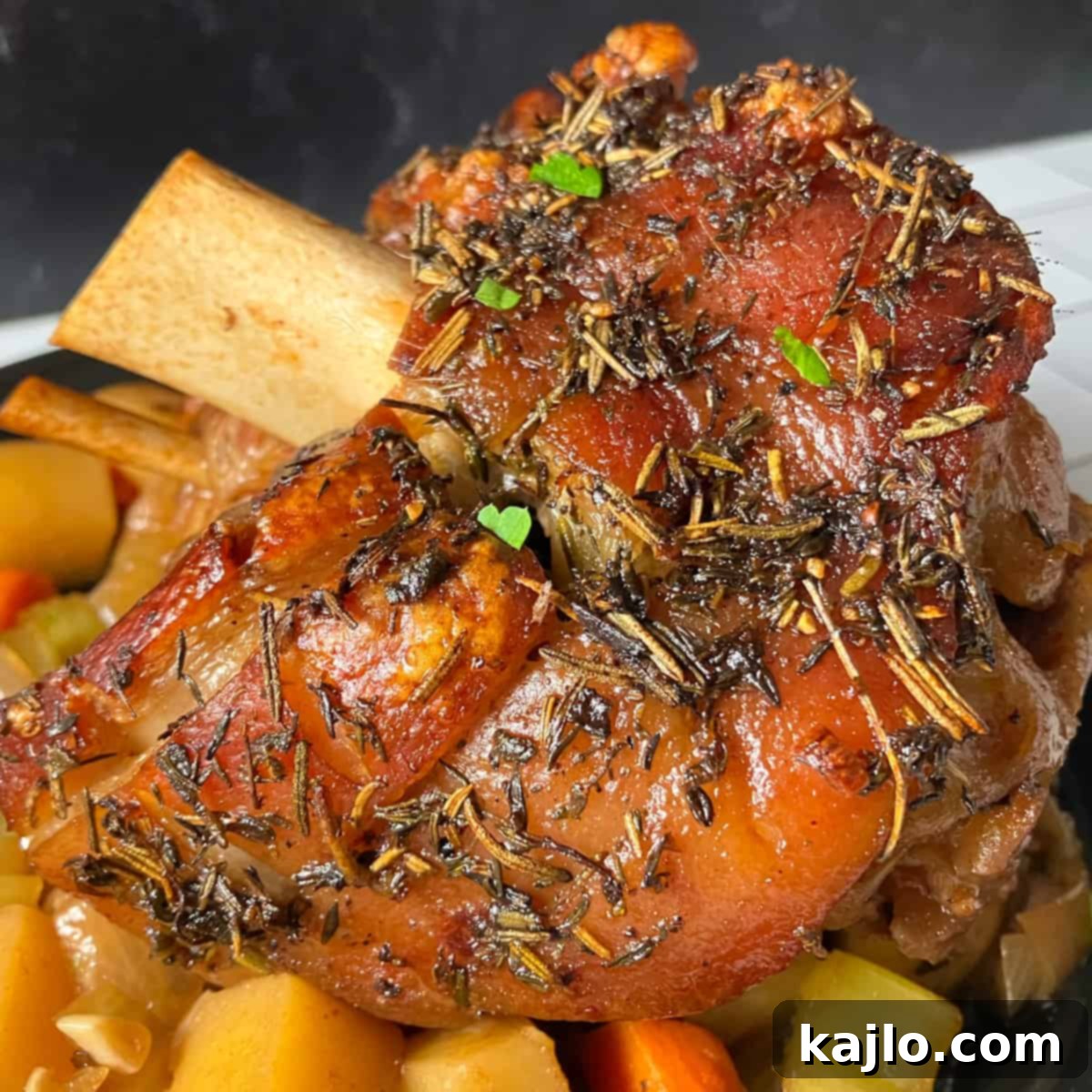Mastering the Art of Cooking Ham Shank: A Comprehensive Guide
Unlock the secrets to preparing a succulent ham shank that’s surprisingly easy and incredibly rewarding. Whether you’re dealing with a raw pork shank, a smoked ham shank, or a precooked one, this guide will walk you through every step. Discover expert tips on selecting the best ham shank, understanding different cooking methods, how long to cook it to perfection, and even how to carve it with ease. Learning to cook ham shank not only saves money but also allows you to create a truly memorable meal for any occasion. Get ready to impress your family and friends with a dish that’s rich in flavor and tradition!
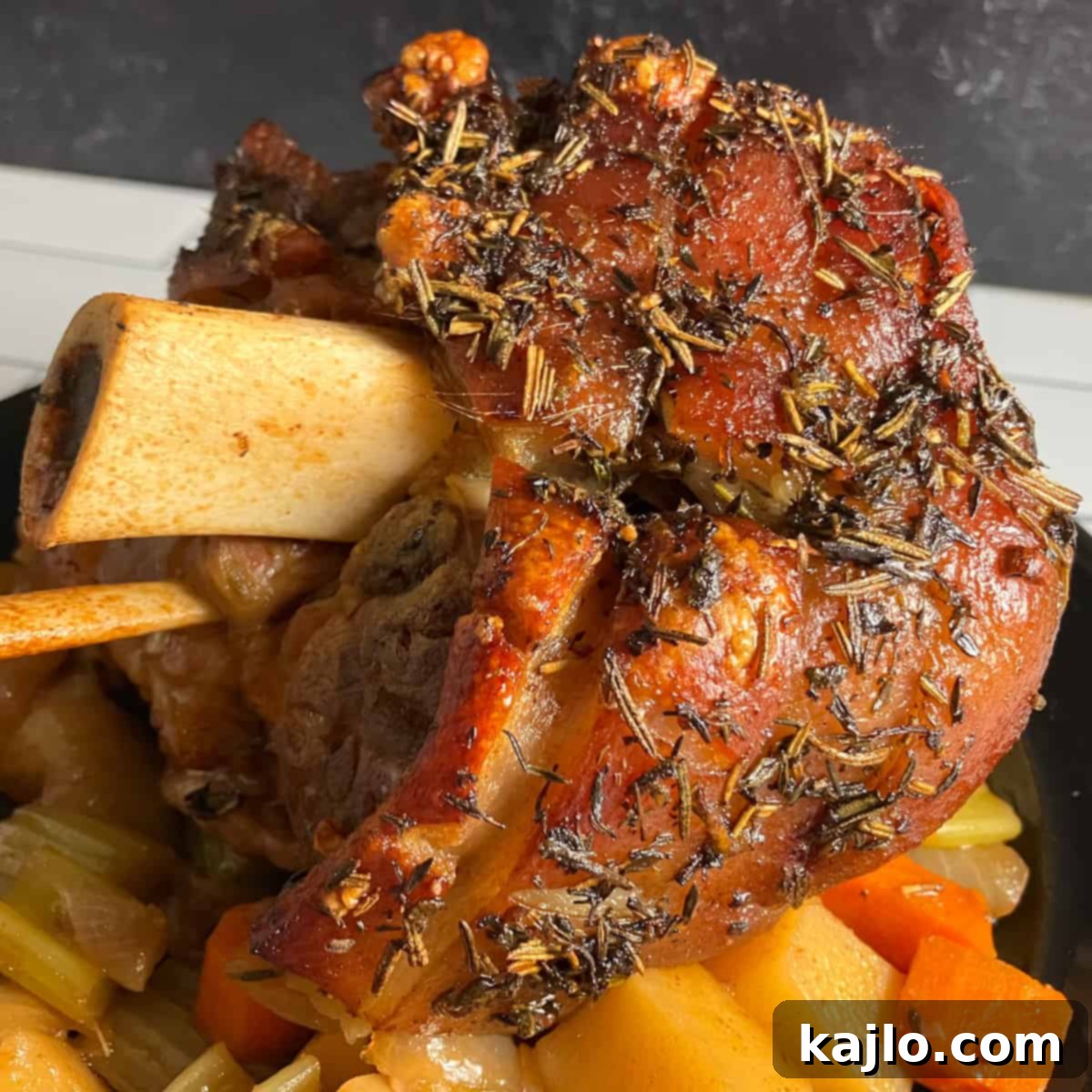
What is a Ham Shank?
A ham shank is a distinct cut of pork derived from the lower portion of the pig’s leg. It comprises the leg bone, surrounding muscles, and a flavorful layer of fat and skin. Located just beneath the shoulder or hip, the shank is known for its rich, savory taste and its ability to become incredibly tender when cooked properly. In the United States, ham shank is a popular choice for baked ham, particularly during holiday seasons, valued for its robust flavor and cost-effectiveness compared to other ham cuts.
Raw vs. Precooked Ham Shank: What You Need to Know
The culinary world often distinguishes between two primary forms of ham shank: raw and precooked. Often, what’s referred to as “pork shank” is the raw, uncured version, requiring a longer cooking time to reach desired tenderness and safety. Conversely, many “ham shanks” available in stores are either smoked, cured, or both, meaning they are already precooked. While some may use the terms “ham shank” and “pork shank” interchangeably, it’s crucial to identify which type you have to ensure proper preparation and cooking times.
The cooking method for your ham shank largely depends on whether it’s raw or precooked. This guide will provide detailed instructions for both raw pork shank, ideal for slow braising in the oven, and precooked ham shank, perfect for a shorter bake with a delicious glaze. For those interested in alternative cooking methods, you’ll also find tips for preparing ham shank in a slow cooker within our FAQ section.
Ham Shank Terminology and Distinctions
Beyond “pork shank,” ham shanks are sometimes simply called pork shanks. However, it’s important to clarify that “ham shank” and “ham hock” are not the same cut. Ham hocks are sourced from further down the leg, typically below the shank portion, and are smaller and less meaty. Understanding these distinctions helps in selecting the right cut for your culinary masterpiece.
🏆 The Best Way to Cook a Ham Shank
From my experience, the optimal method for cooking a raw ham shank is a slow braise in the oven. This technique allows the meat to break down gradually, resulting in incredibly tender, fall-off-the-bone pork with rich, developed flavors. Towards the end of the cooking process, a blast of high heat helps achieve a wonderfully crispy skin, adding delightful texture. For precooked ham shanks, a shorter baking time combined with a flavorful glaze yields the best results, ensuring the ham is thoroughly heated and beautifully caramelized without drying out.
🥘 Essential Ingredients for Your Ham Shank Recipe
To prepare a perfectly cooked raw ham shank, you’ll need a selection of aromatic ingredients and standard kitchen tools. This combination ensures a deeply flavorful and tender result:
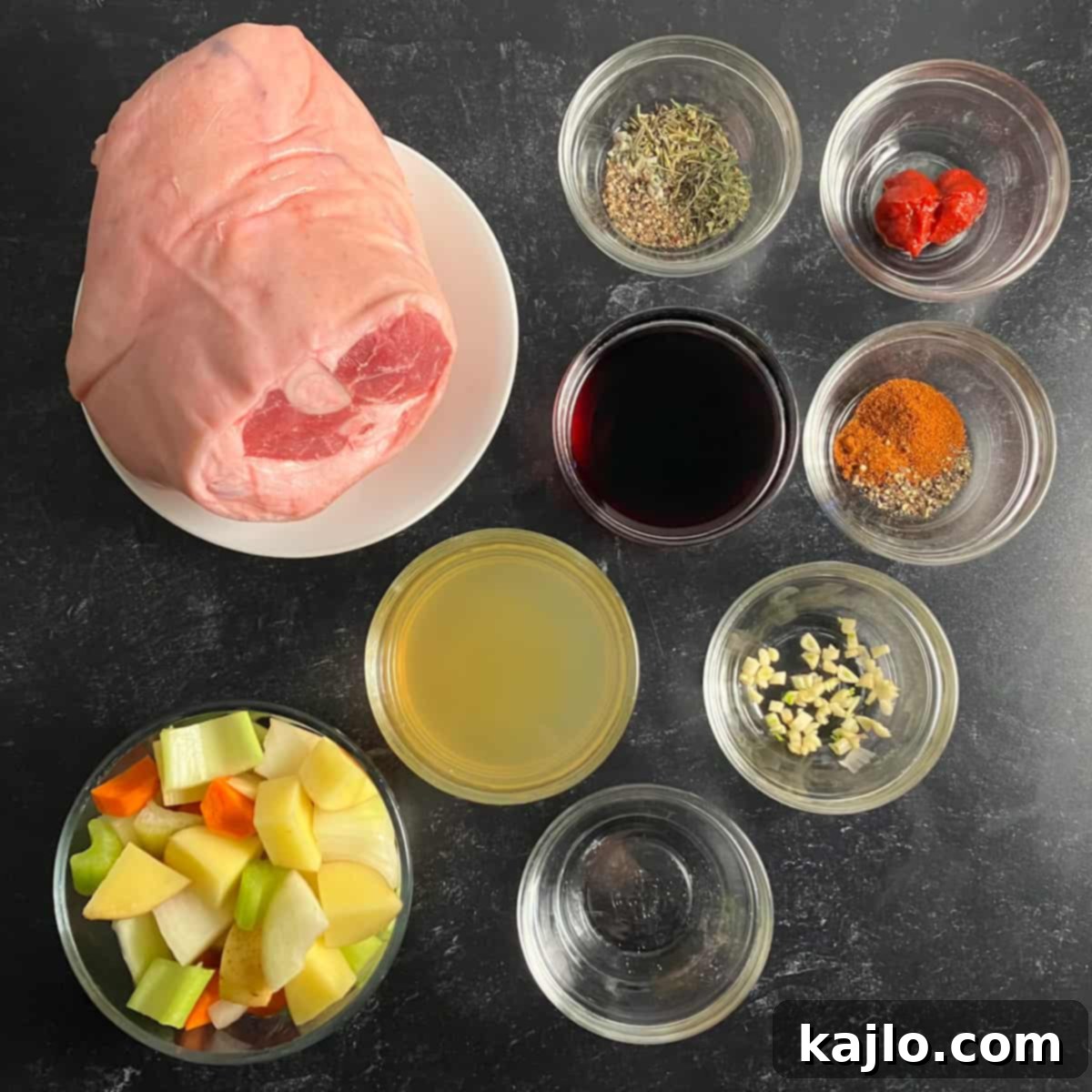
- 2 lbs. raw ham shank, bone-in, skin on (approx. 907 grams, unsmoaked)
- ½ tablespoon white vinegar
- ¾ cup chicken stock (preferably reduced sodium or no added salt)
- ¼ cup red wine
- ½ tablespoon double-concentrated tomato paste
- ½ teaspoon dried thyme
- ½ teaspoon dried rosemary
- ½ teaspoon dried sage
- ¼ cup sliced carrots
- ¼ cup chopped onion
- ¼ cup chopped celery
- ½ small potato (choose one with thin skin, such as a Yukon Gold)
- 2 minced cloves of garlic
- 1 teaspoon smoked paprika
- Salt and freshly ground black pepper, to taste
You will also need a small cast iron Dutch oven with a lid for optimal braising, an X-Acto knife or utility knife for scoring the skin, a pastry brush for basting, and a whisk for preparing the liquid mixture. For this slow-cooking method, a meat thermometer isn’t strictly necessary, as the extended cooking time ensures the pork is thoroughly done.
Where to Buy Ham Shank Near You
Finding ham shank is relatively easy, especially during peak holiday seasons like Easter and Christmas. Most major grocery stores across the US will stock smoked ham shanks. Brands like Smithfield offer popular country ham shank portion options. You might also encounter butt ham, which is a different cut from the upper part of the leg, above the shank.
Raw pork shank, however, can be more challenging to find in conventional grocery stores. For this particular cut, you may need to visit a specialty butcher shop or inquire with local pork farmers. Alternatively, fresh pork ham shanks can be purchased online from reputable suppliers like US Wellness Meats, which offers convenient delivery directly to your door.
If you’re able to source fresh ham shank locally, it’s often the most economical choice. Availability can vary regionally; for instance, this cut might be more readily available and popular in the southeastern US compared to other areas.
What is the Ham Shank Portion?
A ham shank portion refers to the specific cut of ham taken from the lower leg of the pig. It’s located below the butt end but above the ham hocks. While a ham shank portion might be slightly less meaty than a butt ham, it generally offers easier carving, making it a convenient choice for many home cooks.
🍖 How to Bake a Raw Ham Shank to Perfection
When preparing a raw ham shank with the bone in, the braising method is unparalleled. This technique eliminates the need for a complex ham shank marinade or a heavy sauce, as the slow cooking creates a naturally rich and flavorful broth. The result is consistently tender, juicy meat that practically falls off the bone, offering an exquisite dining experience.
Follow these step-by-step instructions for cooking a raw pork shank in the oven:
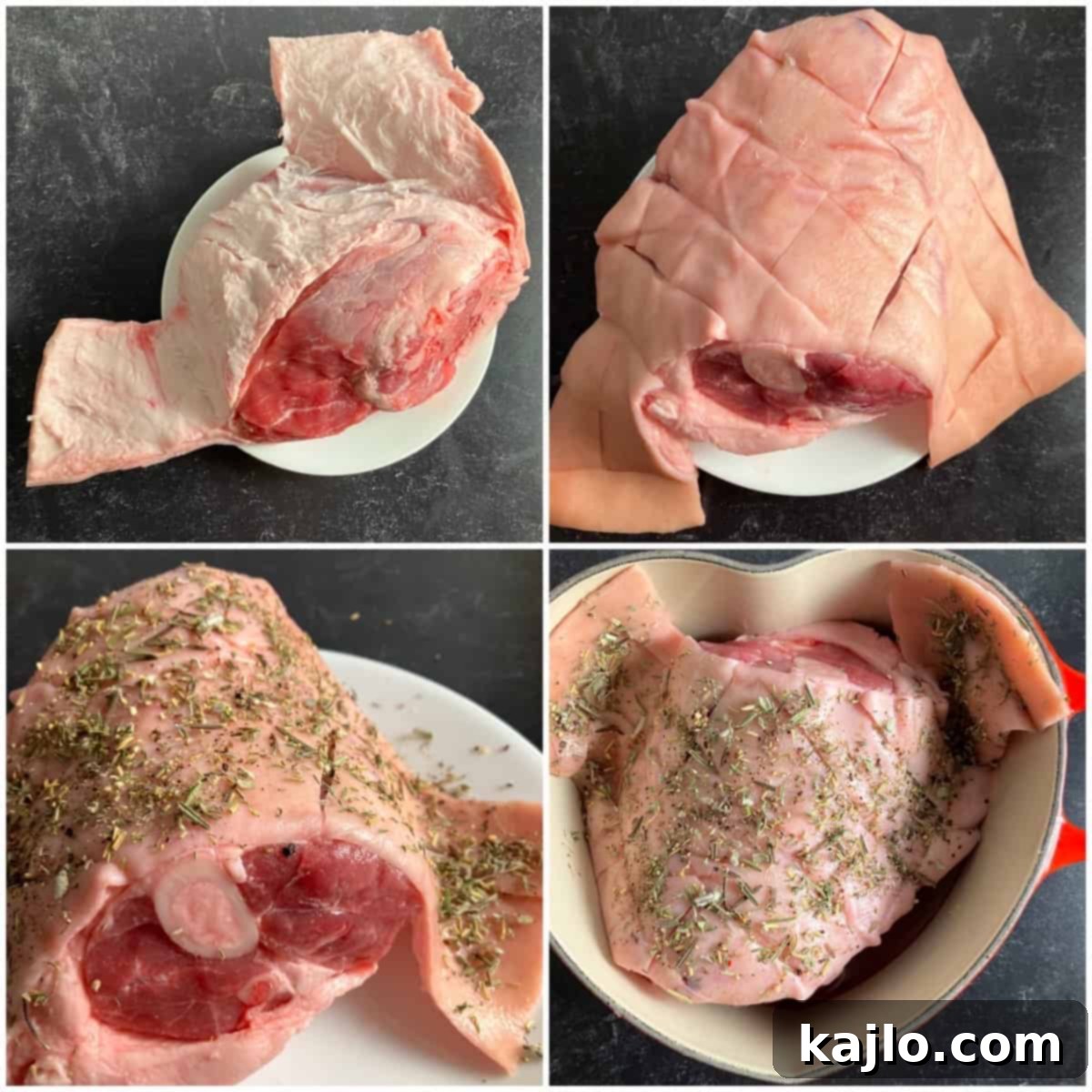
Begin by preheating your oven to 325 degrees Fahrenheit (163°C). This lower temperature is crucial for the slow braising process that tenderizes the meat.
Carefully use an X-Acto knife or a sharp utility knife to gently separate the skin from the bottom of the pork shank. Ensure you leave a thin layer of fat attached to the meat, as this will render during cooking and add tremendous flavor. Allow the detached skin to remain as a flap on each side of the shank.
With the same knife, score the skin in a decorative 1-inch diamond pattern. Be precise and avoid cutting into the flesh beneath the fat layer, as this helps the skin crisp up without drying out the meat. Once scored, thoroughly pat the skin dry with paper towels to prepare it for seasoning.
Lightly brush the scored skin with white vinegar. This helps in rendering the fat and achieving a crispy texture. Then, generously sprinkle the skin with dried sage, dried rosemary, dried thyme, salt, and freshly ground black pepper. These herbs will infuse a fragrant aroma and depth of flavor into the ham.
In a separate bowl, whisk together the chicken stock, red wine, and double-concentrated tomato paste until well combined. Pour this flavorful mixture into a small enameled cast iron Dutch oven. Carefully place the seasoned ham shank into the Dutch oven, ensuring the skin side is facing up. It’s ideal to keep the skin elevated slightly out of the braising liquid if possible, to encourage crisping later.
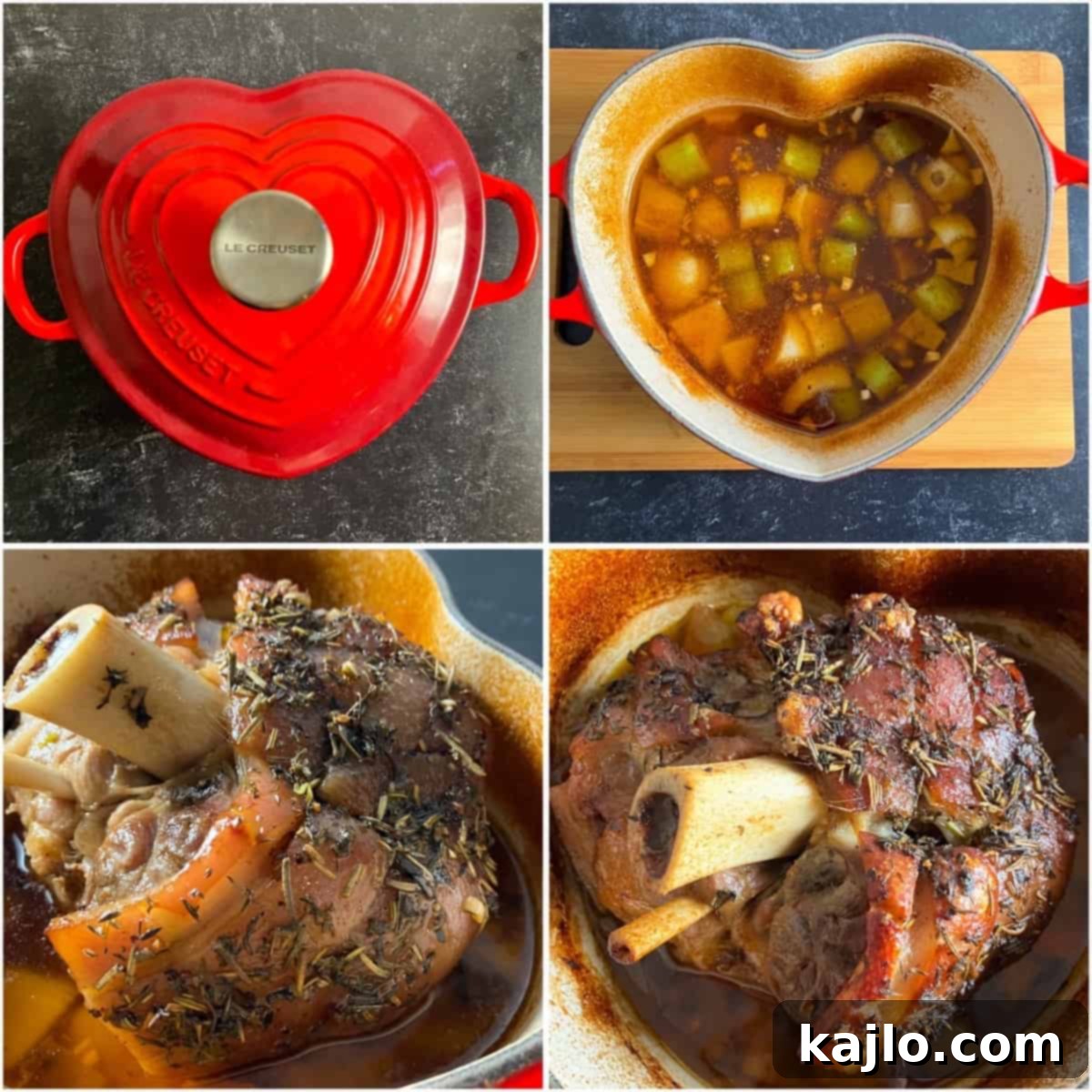
Cover the Dutch oven tightly with its lid and place it in the preheated oven. Allow the ham shank to braise slowly for 2 hours. While it cooks, prepare your vegetables: chop carrots, onion, and celery into ½-inch (1.27 cm) pieces. Cut the potatoes into 1-inch (2.54 cm) pieces and finely mince the garlic. Season these chopped vegetables generously with smoked paprika, salt, and pepper.
After the initial two hours of braising, carefully remove the Dutch oven from the oven. Tuck the seasoned vegetables around the ham shank in the pot, ensuring they are partially submerged in the braising liquid. Briefly baste the vegetables to coat them in the rich flavors. Cover the pot again and return it to the oven for an additional 30 minutes, allowing the vegetables to soften and absorb the delicious aromas.
Now, it’s time to achieve that coveted crispy skin. Remove the lid from the Dutch oven and carefully take out the cooked vegetables. Increase the oven temperature to a high 450°F (232°C). Baste the ham shank generously one more time. Return the uncovered ham shank to the oven and roast for 15-30 minutes, depending on your preferred level of crispiness. Make sure to baste the ham again after about 15 minutes of roasting. The bone should easily separate from the ham shank when it’s perfectly done and tender.
Once cooking is complete, remove the ham shank from the Dutch oven. Transfer it to a cutting board and allow it to rest for 5-10 minutes before slicing and serving. This resting period is crucial for the juices to redistribute throughout the meat, ensuring maximum tenderness and flavor.
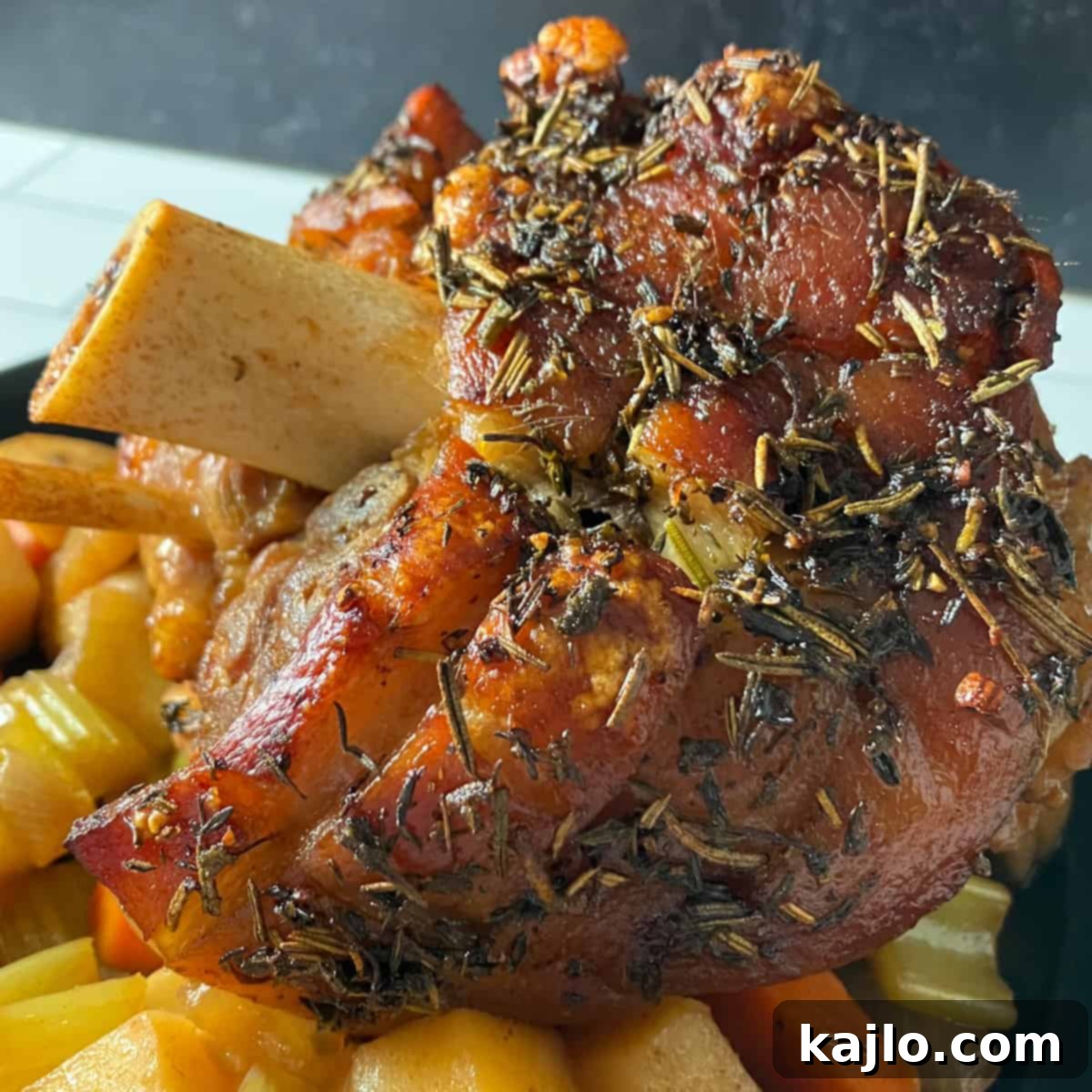
➕ Achieving the Perfect Ham Shank Temperature
For braising a fresh ham shank, maintain an oven temperature of 325°F (163°C) for the initial long cook. Following this, a quick roast at 450°F (232°C) is key to crisping the pork crackling. While the braising process prevents the skin from becoming as intensely crispy as, say, pork belly, you should still achieve satisfyingly crispy strips. Any skin that remains submerged in the cooking liquid should be discarded as it won’t crisp up effectively.
⏲️ How Long to Cook Ham Shank?
The total cooking time for a raw ham shank using this braising and roasting method is approximately 2 hours and 45 minutes to 3 hours. This extended, slow-and-low cooking approach is essential for transforming this economical cut of meat into a truly special dinner or an impressive holiday meal, delivering unparalleled tenderness and rich flavor.
🔪 Expert Tips on How to Carve a Ham Shank
Carving a ham shank might seem daunting, but it’s simpler than you think. You can find detailed carving instructions for a shank half or portion ham here. Don’t stress about achieving absolute perfection; as culinary experts often say, it’s hard to truly go wrong when carving a ham.
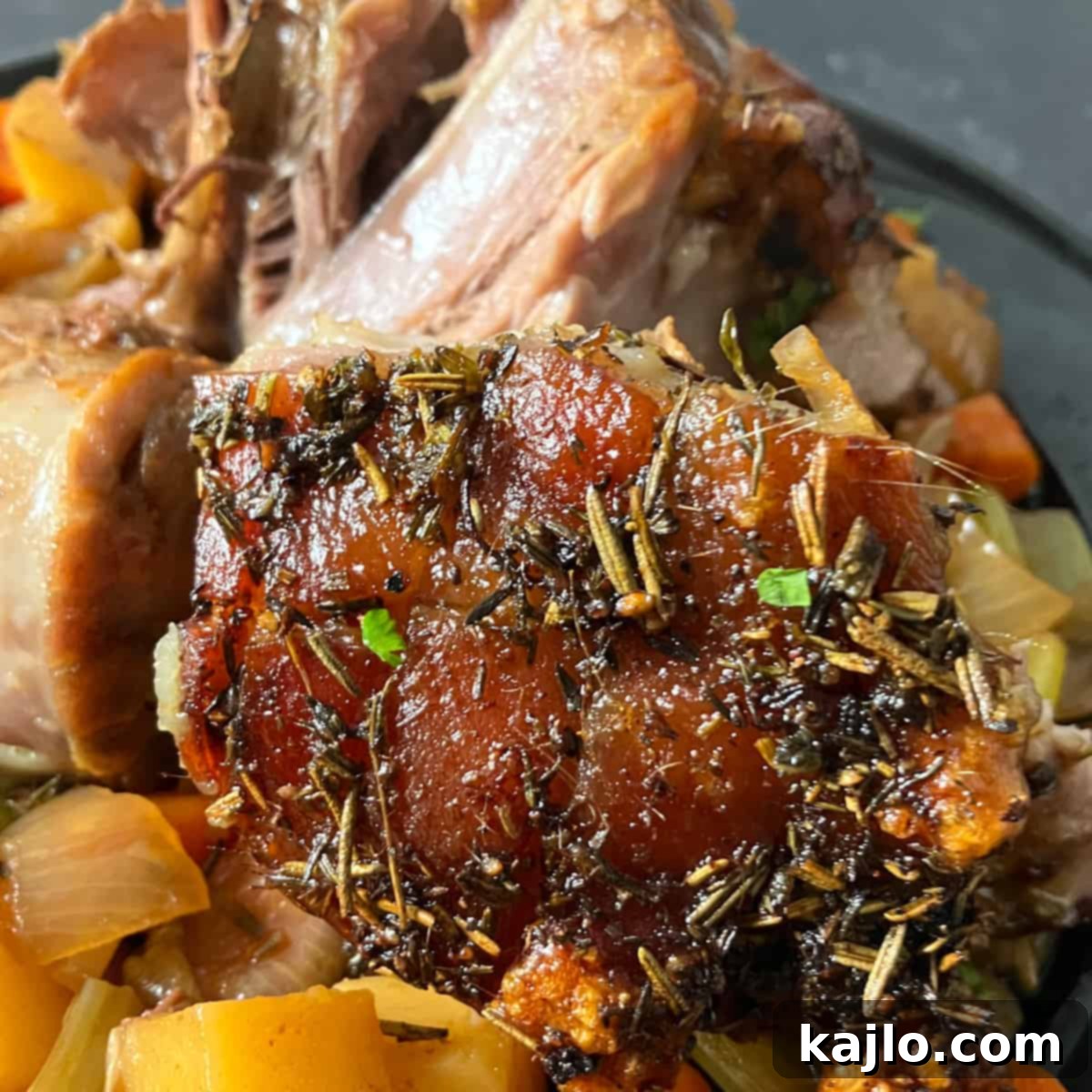
While some prefer the precision and speed of an electric knife for carving meats, a sharp, well-maintained chef’s knife or carving knife works perfectly well. Use the tool you are most comfortable and proficient with. For ultimate convenience and minimal effort, consider purchasing a spiral-cut ham, where the intricate slicing has already been expertly done for you.
🤔 How to Cook a Fully Cooked Shank Ham (Smoked or Precooked)
While we’ve explored cooking a raw shank ham, preparing a smoked or fully cooked ham shank is a quicker process that focuses on reheating and glazing. Here’s a simple and delicious recipe for a honey-glazed ham shank:
Preheat your oven to 325°F (163°C). Place the large smoked shank ham, with the cut side facing down, into a shallow roasting pan. Cover the pan securely with aluminum foil to trap moisture and ensure even heating.
Bake the covered ham for approximately 20-25 minutes per pound, or until it is thoroughly heated through. About 30 minutes before the ham is expected to be done, carefully remove the foil. Apply a generous layer of your prepared glaze (recipe below) over the ham. Continue to bake the uncovered, glazed ham for an additional 25-30 minutes, allowing the glaze to caramelize and form a beautiful, golden crust.
To make the simple honey glaze: Combine 1 part honey, 1 part melted butter, and 2 parts brown sugar in a saucepan. Heat the mixture over medium heat on the stovetop, stirring constantly, until it thickens into a glossy syrup. This glaze provides a perfect balance of sweetness and richness.
Once baked, remove the glazed roast ham shank from the oven and allow it to rest for 5-10 minutes. This allows the juices to settle, ensuring a moist and flavorful ham when sliced and served.
😋 Versatile Ham Shank Recipes and Serving Suggestions
What is ham shank good for? While the raw ham shank recipe above incorporates vegetables primarily for flavor infusion, they aren’t necessarily intended as a side dish. For a complete meal, consider serving your ham shank with classic accompaniments such as creamy mashed potatoes, hearty mushy peas, steamed cabbage, or a fresh green salad to balance the richness.
Beyond being a centerpiece roast, ham shank is exceptionally versatile and highly prized for its use in savory soups. Its bone adds a profound depth of flavor to broths, making it perfect for:
- Comforting ham shank and potato soup
- Traditional ham shank and split pea soup
- Hearty lentil rice soup with ham shanks
- Rich ham shank and bean soup
But the possibilities don’t stop there! You can also incorporate cooked ham shank into a variety of other dishes. Serve slices alongside eggs for a hearty breakfast, dice it into a flavorful stir-fry, or create a classic ham sandwich piled high with mustard and cheese. Another excellent idea is a savory ham shank and beans casserole, offering a warm and filling meal. With so many options, ham shank truly is a culinary chameleon!
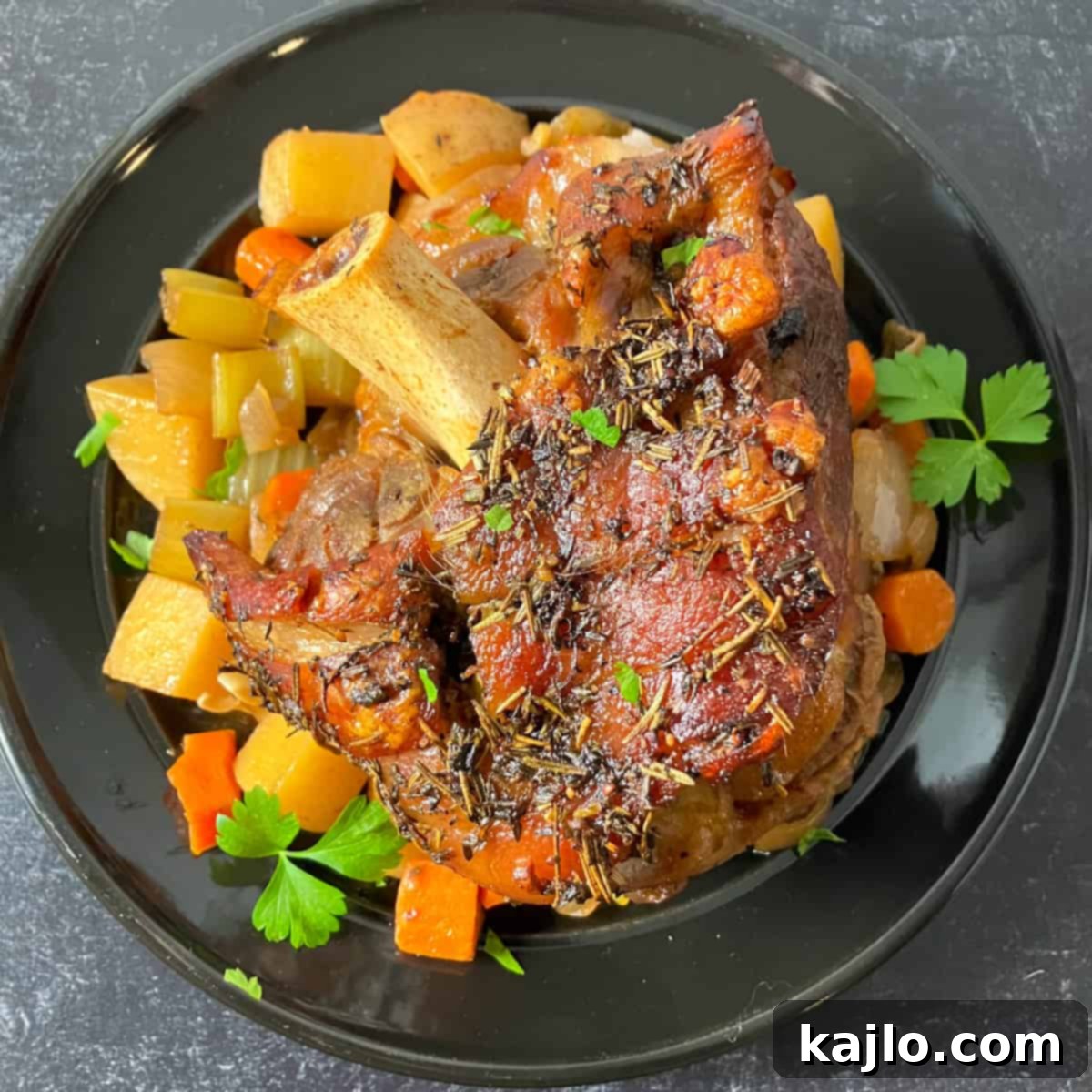
❓ Ensuring Ham Shank Safe Temperature for Consumption
Food safety is paramount when cooking pork. According to the USDA guidelines, uncooked fresh ham shank must be cooked to a minimum internal temperature of at least 145°F (63°C). After reaching this temperature, it is critical to allow the ham to rest for a minimum of 3 minutes before slicing and serving. This resting period not only ensures safety but also helps to redistribute juices, resulting in a more tender and flavorful product.
For precooked hams, which are essentially being reheated, the safety standards are different. These should be treated similarly to leftovers and heated to a minimum internal temperature of 165°F (74°C) to ensure any potential bacteria are eliminated.
🌡️ Storing and Reheating Leftover Ham Shank
While the crispy skin on a freshly cooked ham shank is a delight, it unfortunately does not reheat well. For any leftover cooked ham shank, remove the skin if you prefer. Store the meat in a tightly covered container in the refrigerator for up to 3-4 days to maintain freshness and prevent spoilage.
When it comes to reheating, you have a few options to ensure the meat remains moist and flavorful. You can reheat leftover ham shank in an air fryer at 400°F (200°C) for 3-5 minutes, which can help achieve some crispness on any remaining fat. Alternatively, for a quicker method, microwave ham shank leftovers on high for 1½-2 minutes, or until thoroughly heated through.
Cooked ham shank (without the skin) also freezes exceptionally well, making it a great option for meal prep. To freeze, place the cooled ham in a freezer-safe bag, pressing out as much air as possible before sealing. This method helps prevent freezer burn and preserves the ham’s quality for future meals.
Ham Shank Recipe (How to Cook Ham Shank)
Summer Yule
3 hrs
3 hrs
Dinner
American
4
286 kcal
Ingredients
- 2 lbs. ham shank raw, bone-in, skin on (907 grams, not smoked)
- ½ tablespoon white vinegar
- ¾ cup chicken stock (reduced sodium or no added salt)
- ¼ cup red wine
- ½ tablespoon double-concentrated tomato paste
- ½ teaspoon dried thyme
- ½ teaspoon dried rosemary
- ½ teaspoon dried sage
- ¼ cup carrots
- ¼ cup onion
- ¼ cup celery
- ½ small potato (choose one with thin skin)
- 2 cloves garlic, minced
- 1 teaspoon smoked paprika
- salt and pepper, to taste
Instructions
- Preheat the oven to 325°F (163°C).
- Use an X-Acto knife or utility knife to release the skin from the bottom of the pork shank, leaving a layer of fat on the meat. Leave the cut skin as a flap on each side.
- Score the skin with the knife into a 1-inch diamond pattern, being careful not to cut into the flesh. Pat the skin dry with paper towels.
- Brush the skin with vinegar. Sprinkle with thyme, rosemary, sage, salt and pepper.
- Whisk together the chicken stock, wine, and tomato paste. Put this mixture into a small enameled cast iron Dutch oven. Add the ham shank skin-side up. Try to keep the skin out of the liquid.
- Cover the Dutch oven and allow the ham shank to braise on a rack in the middle of the oven for 2 hours. While it cooks, chop carrots, onion, and celery into ½-inch (1.27 cm) pieces. Chop potatoes into 1-inch (2.54 cm) pieces, and mince the garlic. Season the veggies with smoked paprika, salt, and pepper.
- After two hours, tuck the seasoned vegetables into the pot and baste them. Bake, covered, for 30 minutes.
- Then take the cover off the Dutch oven, remove the veggies, turn the heat up to 450°F (232°C), and baste the ham shank. Roast for 15-30 minutes, depending how crispy you want the skin. Baste after 15 minutes. The bone should separate easily from the ham shank when it’s done.
- After cooking, remove the ham shank from the pot and let it rest 5-10 minutes before slicing and serving.
How to Cook Precooked Shank Ham:
- Preheat the oven to 325°F (163°C). Place a large smoked shank ham, cut-side down, in a shallow roasting pan. Cover with aluminum foil.
- Bake the ham for 20-25 minutes per pound until heated through. One-half hour before the ham is done, uncover the ham and brush on the glaze. Heat the uncovered glazed ham for an additional 25-30 minutes.
- To make the glaze: 1 part honey, 1 part melted butter, 2 parts brown sugar. Heat over medium heat on stovetop until it becomes a syrup.
- Let the glazed roast ham shank rest for 5-10 minutes before slicing and serving.
Equipment
- Small Dutch Oven
- X-Acto Knife
- Silicone Pastry Brush
- Whisk
Notes
Expert Tips from Dietitian Summer Yule
This is a level 3 recipe (weight maintenance and active lifestyles). Is ham shank healthy? As always, the answer to this question depends on what you’re looking for.
Ham shank is a bit leaner than butt portion ham, but it is still rather high in saturated fat. If you’re looking for lean protein, pork tenderloin is a better choice for pork. The lower fat ham options are also lower in calories, and likely a better option if your goal is weight loss.
On the other hand, ham shank is rich in certain vitamins and minerals, including phosphorus, zinc, and many B vitamins. It’s also a high-quality protein that is versatile enough to work well in many dishes.
For the “healthiest” ham shank, I’d opt for a fresh, uncooked ham shank instead of one that’s smoked and cured. The smoked hams are often much higher in sodium, and they may contain added sugar and other additives you don’t want. Additionally, the process of smoking ham creates potentially harmful polycyclic aromatic hydrocarbons (PAHs), just as it does in other preserved meats.
Is ham shank good?
If by good, you mean tasty, my answer is a definitive yes! The only way to know for sure though is to try it for yourself and see.
Nutrition information is for one serving of the ham shank only. This recipe yields about 15 ounces of cooked meat in total (425 grams).
nutrition info disclaimer
All recipes on this website may or may not be appropriate for you, depending on your medical needs and personal preferences. Consult with a registered dietitian or your physician if you need help determining the dietary pattern that may be best for you.
The nutrition information is an estimate provided as a courtesy. It will differ depending on the specific brands and ingredients that you use. Calorie information on food labels may be inaccurate, so please don’t sweat the numbers too much.
“To taste” means to your preferences, which may have to be visual to follow food safety rules. Please don’t eat undercooked food x
Nutrition
Calories: 286kcal
Protein: 31g
Fat: 17g
Saturated Fat: 6g
Calcium: 1% DV
Iron: 6% DV
cooking ham shank, ham shank, ham shank recipe, how long to cook ham shank, how to cook ham shank, pork shank, pork shank recipe, recipe for ham shank
Shop our cookbook!
Easy Air Fryer Recipes for One
Burning your air fryer recipes?
Here’s how to fix it!
📋 Ham Shank Nutrition Facts
Understanding the nutritional profile of fresh ham shank can help you incorporate it into a balanced diet. Here is an estimated nutrition breakdown per 4-ounce serving (approximately 112 grams), based on data from Cronometer:
- Calories: 286 kcal
- Total Fat: 17g
- Saturated Fat: 6g
- Cholesterol: 92mg
- Sodium: 54mg
- Total Carbohydrate: 0g
- Fiber: 0g
- Sugar: 0g
- Protein: 31g
- Vitamin A: 0.2% DV
- Vitamin C: 0% DV
- Calcium: 1% DV
- Iron: 6% DV
It’s important to note that this nutrition information pertains to the ham shank itself. While the vegetables cooked with the ham are certainly nutritious and the collagen-rich broth can make a fantastic gravy (easily thickened with flour or cornstarch!), their nutritional contributions are not included in this specific breakdown.
Ham shank is naturally a low-carb, keto-friendly, dairy-free, and gluten-free food, making it suitable for various dietary preferences. However, if you choose smoked or otherwise preserved ham shanks, always check the nutrition facts panel and ingredient list. These products may contain added sugars, higher sodium levels, and potential allergens from curing processes.
Common Questions About Ham Shank
How to make a ham shank crock pot recipe?
For a hands-off approach to cooking ham shank, a slow cooker or Crock-Pot is an excellent choice. You can find a highly-rated slow cooker brown sugar ham shank recipe here. Glazed with a delectable blend of brown sugar, Dijon mustard, and honey, it promises to be exceptionally flavorful and tender!
Ham Shank vs Ham Hock – What’s the Difference?
Understanding the distinction between these two cuts is key. A ham hock comes from the pig’s leg above the ankle, near the foot, and contains more bone and connective tissue with less meat. In contrast, a ham shank is from the pig’s leg below the hip, offering a much meatier portion with a significant bone running through it (source). While both are typically bone-in, ham shanks provide a more substantial amount of edible meat.
Can you use ham shank in place of ham hock?
Yes, absolutely! Ham shank and ham hock are often interchangeable in many recipes, particularly those where the primary goal is to impart a smoky, savory flavor to soups, stews, or braised dishes. The main consideration is that using a ham shank will result in a significantly greater amount of meat in your final dish compared to a ham hock.
Which is better: shank ham or spiral ham?
The choice between shank ham and spiral ham largely depends on your priorities. A spiral ham is a precut ham, typically sliced in a continuous spiral down to the bone, offering incredible convenience for carving and serving. You can find both shank hams and butt hams prepared as spiral cuts. While spiral-sliced hams are undeniably easy to carve, they are more prone to drying out during cooking than a whole, uncut ham. If moisture and deep flavor are your top priorities, a traditional shank ham that you carve yourself might be preferred. If ease of serving for a crowd is key, a spiral ham is an excellent option, though you might need to take extra steps to keep it moist.
What is equivalent to ham hock?
Ham hocks are typically used in recipes for their distinctive smoky flavor and collagen-rich texture. If you don’t have a ham hock, suitable cooking substitutes that offer similar smoky notes include chopped smoked shank ham, other smoked ham cuts (like bacon or ham chunks), or even smoked turkey legs or wings. These alternatives will help replicate the desired flavor profile in your dishes.
How to make Instant Pot ham shank?
For a considerably faster cooking time compared to traditional slow cooking or oven braising, the Instant Pot or pressure cooker is an excellent method for ham shank. Pressure cooking effectively tenderizes the meat in a fraction of the time. You can find a detailed recipe and instructions for making smoky ham hock (which can be substituted with ham shank for more meat) and pinto bean soup in a pressure cooker here, offering a delicious and time-efficient meal.
👩🏻🍳 Discover More Delicious Pork Recipes
If you’ve enjoyed mastering the ham shank, you’ll love exploring other flavorful pork dishes. Here are some more inspiring dinner recipes featuring pork to add to your culinary repertoire:
- Air Fryer Pork Roast (Boston Butt): A quick and easy way to get a tender, juicy pork roast.
- Pork Belly Air Fryer Recipe: Achieve irresistibly crispy pork belly with minimal effort.
- Chorizo Recipe: Learn how to make fresh, homemade Mexican chorizo sausage from scratch.
- Air Fryer Bacon-Wrapped Pork Tenderloin: An elegant yet simple dish, combining lean pork with savory bacon.
And if your interest in the shank cut extends beyond just ham, don’t miss this incredible Sous Vide Osso Buco recipe, which features tender beef shank cooked to perfection.
Join our community! Subscribe for all of the latest and greatest recipes, and follow me on Facebook, Pinterest, Instagram, and YouTube!
